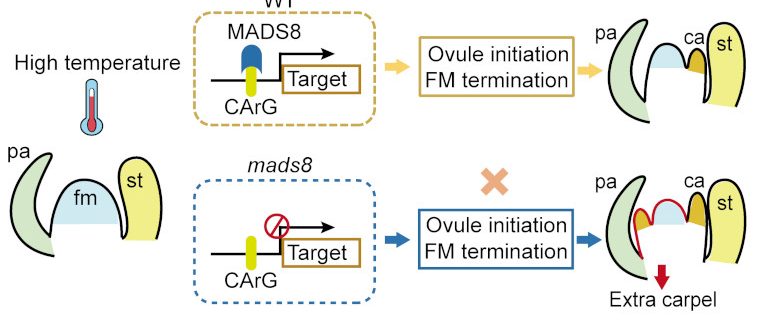Conserved function of MADS8 in pistil regulation at high temperatures
Shen et al. explore how female reproductive development is maintained in at high ambient temperatures in barley and rice, and whether members of the SEPALLATA subfamily of floral organ regulators contribute.
https://doi.org/10.1093/plcell/koad246
Chaoqun Shena,b and Matthew R. Tuckerb
a Joint International Research Laboratory of Metabolic and Developmental Sciences, State Key Laboratory of Hybrid Rice, School of Life Sciences and Biotechnology, Shanghai Jiao Tong University, Shanghai 20040, China
b Waite Research Institute, School of Agriculture, Food and Wine, The University of Adelaide, Waite campus, Glen Osmond, South Australia, Adelaide 5064, Australia
Background: Temperature is a major factor regulating plant growth and phenotypic diversity. When exposed to temperature fluctuations, plants must maintain the developmental stability of their sexual organs in order to survive and reproduce, especially in the face of current and expected global warming trends. In the grass family, the development of the four concentric flower whorls including the pistil, the innermost female reproductive organ, contributes directly to reproductive success. However, the genes and mechanisms maintaining floral organ identity and development in response to high temperature remain underexplored.
Question: We wanted to know how female reproductive development is maintained in cereal crops at high ambient temperatures, and whether members of the SEPALLATA subfamily of floral organ regulators contribute.
Findings: We discovered that barley (Hordeum vulgare) and rice (Oryza sativa) MADS8 genes are indispensable for female reproductive development at high temperatures. Knockout mutants lacking functional MADS8 exhibited multiple pistils with no ovule at high ambient temperatures. We also showed that HvMADS8 increases its binding to the promoters of its downstream target genes in a temperature-responsive manner, which maintains floral meristem determinacy and ovule initiation at high temperatures. Our results shed light on the conserved molecular mechanism that stabilizes female reproductive development in grass species exposed to high temperatures, extending the known functions of floral organ identity regulators.
Next steps: We aim to stabilize and improve crop yields under high-temperature conditions. Further study will focus on understanding pathways regulating reproductive organ development in greater detail, and engineering plants with improved developmental stability in the context of global warming by manipulating the expression of these key regulators.
Reference:
Chaoqun Shen, Yueya Zhang, Gang Li, Jin Shi, Duoxiang Wang, Wanwan Zhu, Xiujuan Yang, Ludovico Dreni, Matthew R. Tucker and Dabing Zhang (2023) MADS8 is indispensable for female reproductive development at high ambient temperatures in cereal crops. https://doi.org/10.1093/plcell/koad246




